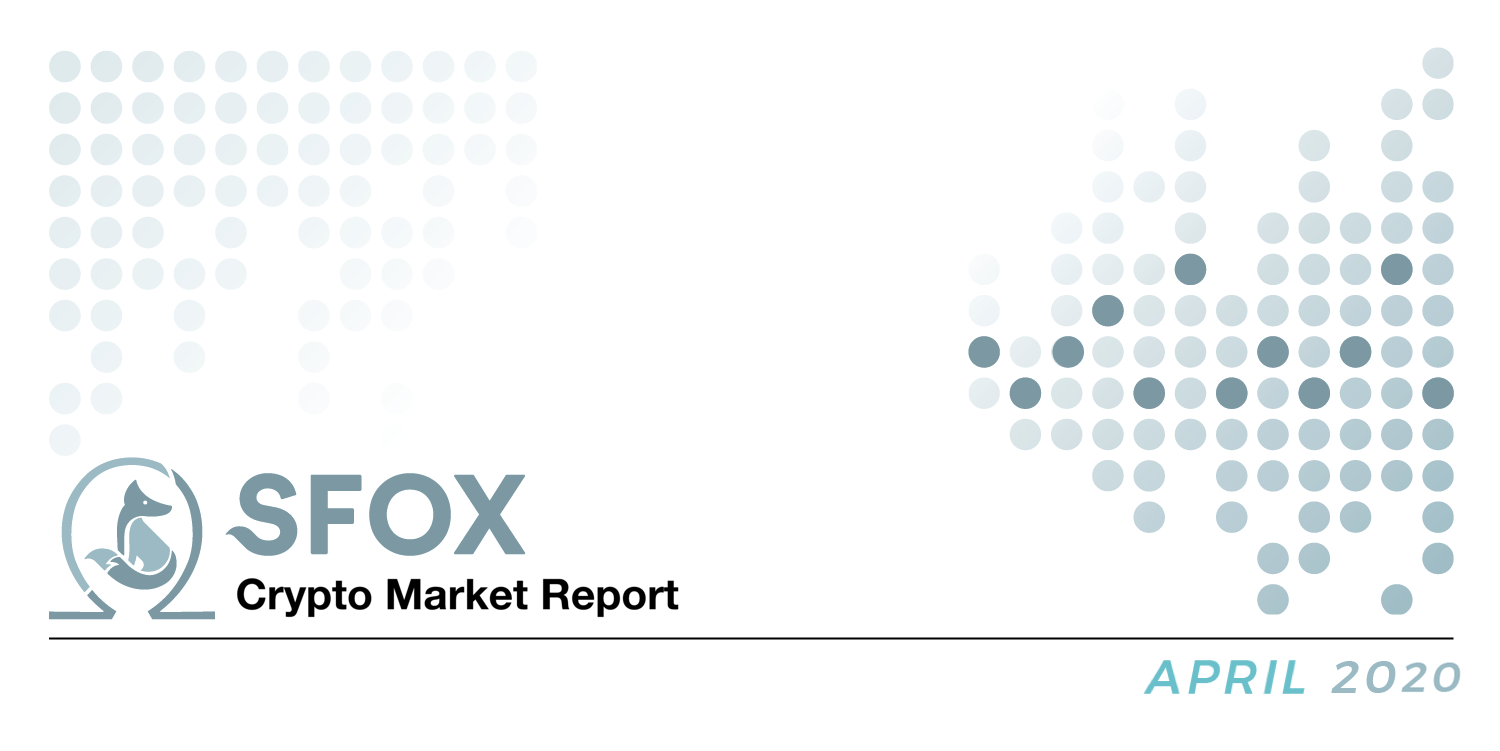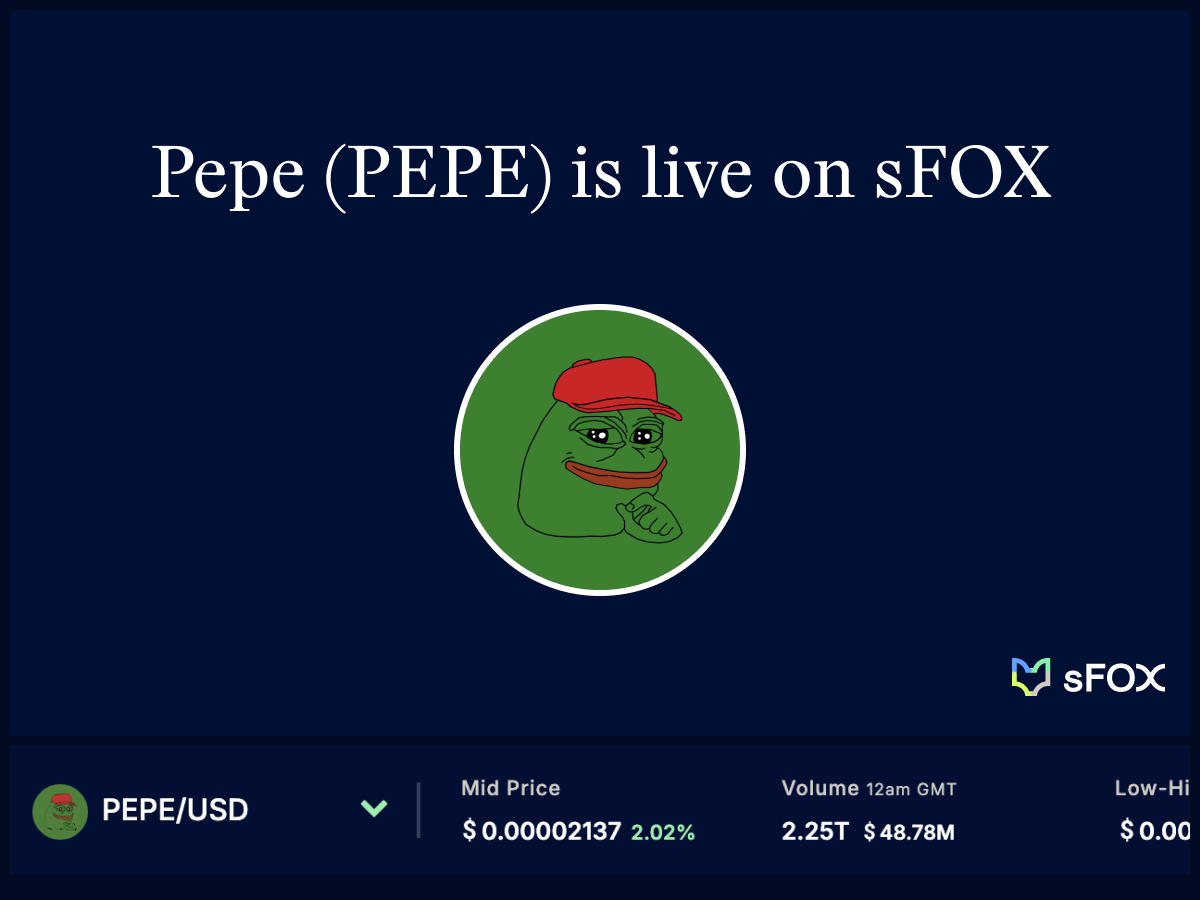Summary:
- All crypto assets are down month-over-month as of April 8th; BTC is down 13.14%, while BSV has the least losses (-0.61%). The S&P 500 is down 4.35% month-over-month; gold is up 0.55% month-over-month.
- The SFOX Multi-Factor Market Index has been updated from neutral to mildly bearish as of April 8th. The index has also been upgraded to include new factors and better capture the current state of crypto’s development.
- Watch for new developments on the Bitcoin halving, the COVID-19 pandemic’s impact on markets, and DeFi’s response to COVID as potentially impacting the crypto market in the coming month.
In the April 2020 edition of the SFOX crypto market report, the SFOX Research Team reviews the crypto market’s volatility, correlations, and other performance metrics throughout the past month. We’ve aggregated price, volume, correlations, and volatility data from eight leading exchanges and liquidity providers to analyze the global performance of 7 major crypto assets — BTC, ETH, BCH, LTC, BSV, ETC, and RVN — all of which are available for smart-routing-powered trading on our trading platform.
The following is a report and analysis of their volatility, price correlations, and further development in the month of March and early April. (For more information on data sources and methodology, please consult the appendix at the end of the report.)
SFOX’s Current Crypto Market Outlook: Slightly Bearish
Based on our calculations and analyses, the SFOX Multi-Factor Market Index, which was set at neutral a month ago, has been updated to mildly bearish as of April 8th, 2020.
We determine the monthly value of this index by using proprietary, quantifiable indicators to analyze five market factors: price momentum, trade volume, market sentiment, volatility, and continued advancement of the sector. It is calculated using a proprietary formula that combines quantified, marketwide data on asset performance, search traffic, blockchain transactions, and more. The index ranges from highly bearish to highly bullish.
All crypto assets tracked by the SFOX market report showed month-over-month losses as of April 8th, along with the S&P 500. Gold showed modest positive month-over-month returns of +0.55%. Among the crypto assets available for trading on SFOX, Bitcoin SV (BSV) stood out as losing just -0.61% month-over-month, the smallest losses recorded. At the other end of the spectrum, Ravencoin (RVN), also available for trading on SFOX, showed the steepest month-over-month losses, losing 31.59%.

The fact that the outlook index is rated mildly bearish despite the moderate recovery in BTC’s price may represent the sustained uncertainty we’ve witnessed in the past month regarding the macroeconomic climate of a COVID-19 world, along with continued debate about the potential impact of the upcoming block reward halving. Bitcoin and blockchain-based infrastructure are theoretically poised to potentially help ameliorate some of the issues that come with the new day-to-day reality that the pandemic has brought upon us, but there’s not much by way of historical data to help us understand how this kind of global public health crisis will continue to evolve and impact markets in the coming months. The simple fact is that we don’t yet have enough data to understand how crypto and Bitcoin will function in this kind of crisis, and that fact may have some market participants nervous.
Get the SFOX edge in volatile times through our smart-routing order types that capture the best available crypto prices from all major trading venues directly from your SFOX account.
What’s Happened in the Last Month and What to Watch Next
Markets
BTC’s behavior during the onset of COVID-19 as a global pandemic suggested that it is behaving as a financial asset and a risk asset (March 12th — 16th).
As we highlighted in our most recent SFOX research report, the onset of COVID-19 last month saw the biggest single-day losses for BTC and the S&P 500 in over three years:
From March 1st to March 16th, BTC’s price fell 42.72%; the S&P 500’s price fell 18.62%; gold’s price fell 3.19%. The correlations between BTC, the S&P 500, and gold also became much more positive than they had been in the previous four and a half months:
At the same time that these correlated price decreases were happening, leverage was massively unwinding: the week of March 16th, $7.3 billion moved out of bond funds and total assets in government money-market funds rose to an all-time-high of $3.09 trillion, according to Bloomberg. At the same time, open interest in Bitcoin, much of which was leveraged, was cut almost in half, decreasing from about $3.75 billion to about $2 billion.
The movement of correlations between asset classes toward 1 and the unwinding of leverage suggest that COVID-19 may have contributed to financial contagion: a flight to liquidity and movement of investors into cash in a risk-off environment following a black swan event.
The SFOX research team concluded that Bitcoin’s behavior here is “another data point that BTC is a risk asset. BTC’s price fluctuations as global markets moved to risk-off provide more evidence that, at least at this point in its history, BTC is a risk asset. This is something to keep in mind regardless of whether or not one expects that BTC will be a stable, low-risk asset in the long-run: it’s perfectly compatible both to believe that BTC will ultimately be a store of value and to recognize that it’s currently a highly volatile risk asset.”
Individual crypto exchanges have seen difficulty staying online during turbulent market conditions (March 13th; April 8th).
Several leading crypto exchanges saw major unplanned service outages during the increased volatility of crypto markets in March. Leveraged trading platform BitMEX, most prominently, was down for about half an hour, during which time traders could not make orders or manage their open trades, even as the price of BTC significantly and quickly corrected from an almost 30% decrease in the space of three and a half hours.
In a similar vein, decentralized crypto exchange Bisq halted trading on April 8th due to a critical security vulnerability that allowed bad actors to siphon funds from individual traders.
For its part, SFOX has experienced no downtime despite seeing a 30x increase in trading volume, and our platform’s integration with 20 different trading venues allows users to keep trading even if one or several exchanges experience this kind of an outage.
Products
Trading firms in Chicago have formed an alliance to help accelerate and foster decentralized finance products to help combat the macroeconomic conditions of COVID-19 (April 8th).
TD Ameritrade, Cumberland, CMT Digital, DV Trading, Jump Capital, Volt Capital, and Compound announced the formation of the Chicago DeFi (decentralized finance) Alliance. The group aims to provide advisory services to crypto startups, with a focus on helping startups to survive the hardships of the current global health crisis. As Soona Amhaz, co-founder of Volt Capital, said, the alliance aims to help startups get “up and running during the crisis” and subsequently remain “as insulated from macro conditions” as feasible. While the COVID-19 pandemic is furnishing all manner of industries with challenges, it may provide an opportunity to accelerate the adoption of decentralized, blockchain-based financial infrastructure, as Fifth Era co-founder and Managing Partner Matthew Le Merle detailed in a recent blog post.
Visa announces a new credit card that gives rewards in BTC (April 9th).
In partnership with Fold, Visa is offering a new card that credits “as much as 10% of cash purchases” to users in BTC. Fold CEO Will Reeves said that this offering reflects the market’s current interest in accumulating BTC rather than spending it, and that offering it as a reward alongside familiar options like airline miles shows the maturation of the crypto sector. New mainstream products such as this are critical in helping to make crypto adoption a mainstream phenomenon.
Regulatory
The Indian Supreme Court struck down a ban on banking support for crypto (March 5th).
After two years, the Supreme Court of India struck down the Reserve Bank of India’s circular, which had banned regulated financial institutions from providing services to crypto businesses. This ruling paves the way for new integration between crypto- and blockchain-based finance and traditional financial institutions, making new innovations and financial infrastructure possible.
Technical Developments
“Block reward reduction season” has begun (March 16th; April 8th).
In the coming months, several major blockchains are having scheduled reductions in the amount of crypto assets rewarded for the successful mining of a new block. Ethereum Classic (ETC) kicked this off on March 16th, reducing its block reward by 20%. While ETC’s movements still seemed to mostly follow BTC’s, it’s worth noting that its correlation to BTC did dip in the days leading up to the block reward reduction, suggesting that the market may have been watching and trading with expectations of price movement around this reduction in rate of new ETC supply.
Bitcoin Cash saw its own block reward cut in half on April 8th. Its trade volume increased 50.39% from April 7th to April 8th, and the price of BCH increased 4.72% during the same period, from $256.41 to $268.50.
Bitcoin SV is expected to have its block reward halving in roughly three hours at the time of writing (April 9th), which could potentially be a partial explanation for why it is currently fairing better in terms of month-over-month returns than other crypto assets are. Bitcoin is expected to have its much-anticipated block reward halving on May 13th. The lesson from the data so far seems to be that current block reward reductions are correlating with modest price movements, but Bitcoin’s specific halving has experienced so much press and analysis that it may not be possible to infer from other halvings how BTC will perform during its upcoming halving.
The Details: Crypto Price, Volatility, and Correlation Data, March 1 — April 8, 2020
Price Performance: Dive and Recovery
Bitcoin (BTC) began March 2020 at the price of $8549.35 before declining to a low of $4897.10 on March 16th. Since then, the price of BTC has climbed back up to the mid-$7000s, at a price of $7300.93 as of April 8th — still down 14.60% from the start of March.
For better visibility of ETC and RVN price movements, please consult the following graph:
March 12th showed the steepest single-day losses for BTC in over three years, with a 21.70% price decrease in a single day.
For greater graphical clarity, see this additional chart tracking only the daily returns of BTC, ETH, gold, and the S&P 500:
All leading crypto assets showed month-over-month losses as of April 8th. BSV lost the least (-0.61%), while RVN lost the most (31.59%). Gold stood out with slight month-over-month gains (+0.55%).
For greater graphical clarity, see this additional chart tracking only the month-over-month changes in the prices of BTC, ETH, gold, and the S&P 500:
Volatility: Categorical Increase
The 30-day historical volatility of all assets tracked by the SFOX crypto market report increased in the last month, most likely due to the onset of COVID-19, as discussed above. BTC’s 30-day historical volatility began March at 38.45% and currently stands at 134.42%. In general, the volatilities of crypto assets varied across a wider range on April 8th than they did on March 1st: as of April 8th, BSV has the highest 30-day historical volatility (180.86%) and RVN has the “lowest” (75.54%).
By looking at the 30-day historical volatilities of ETH, BCH, LTC, BSV, ETC, and RVN as a percentage of BTC’s 30-day historical volatility, we can see that altcoin’s volatilities all decreased relative to BTC over the course of the month, stabilizing near the middle of March (indicating most of altcoin volatility is explained by BTC volatility).
Price Correlations: Close with BTC; Close with Other Markets
The most recent crypto correlations data show that BTC is seeing high correlations with all other tracked crypto assets, with the exception being ETC, potentially due to its block reward decrease (note, though, that a 0.705 correlation between BTC and ETC is still quite high). As discussed earlier, we’re seeing unusually positive correlations between BTC, the S&P 500, and gold, potentially due to financial contagion.
See the full SFOX crypto correlations matrix below:
For a more complete look at BTC’s correlations with other assets throughout the past month, see the following graph:
About SFOX: Since 2014, SFOX has been providing institutions, pro traders, and anyone serious about trading crypto with the most advanced investment platform available anywhere. Capture the best prices on BTC, ETH, LTC, BCH, BSV, ETC, and RVN anywhere in the crypto market from a single trading account with smart-routing order types you won’t find anywhere else. Sign up now and see why SFOX has facilitated over $11 billion in trading volume to date.
Appendix: Data Sources, Definitions, and Methodology
All cryptocurrency prices are denominated in USD unless otherwise noted.
Note that data collection for RVN began on February 2nd of this year, which is why RVN is not yet featured in all data analyses. RVN is also denominated in USD for ease of analysis and comparison with other crypto assets, though most RVN trading currently happens in the RVN/BTC pair.
Note also that the SFOX Multi-Factor Market Index underwent a substantial revision in methodology this month in order to more accurately capture objective and informative data about the current crypto market as compared to the market’s state in the recent past.
We use two different in-house volatility indices in creating these reports:
1. 30-day historical volatility (HV) indices are calculated from daily snapshots over the relevant 30-day period using the formula:
30-Day HV Index = σ(Ln(P1/P0), Ln(P2/P1), …, Ln(P30/P29)) * √(365)
2. Daily historical volatility (HV) indices are calculated from 1440 snapshots over the relevant 24-hour period using the formula:
Daily HV Index = σ(Ln(P1/P0), Ln(P2/P1), …, Ln(P1440/P1439))* √(1440)
S&P 500 performance data are collected from Yahoo! Finance using GSPC (S&P 500 Index) data. Gold performance data are collected from Yahoo! Finance using GC=F (June 2020 gold futures contract) data.
30-day asset correlations are calculated using the Pearson method, in accordance with the following formula:
In our calculations, x = 30-dayreturns for BTC/USD, y = 30-dayreturns for the other asset in consideration, and r = the correlation coefficient between BTC and the other asset in consideration.
The crypto asset data sources aggregated for crypto prices, correlations, and volatility indices presented and analyzed in this report are the following eight exchanges, the order-book data of which we collect and store in real time:
- bitFlyer
- Binance
- Bitstamp
- Bittrex
- Coinbase
- Gemini
- itBit
- Kraken
Our indices’ integration of data from multiple top liquidity providers offers a more holistic view of the crypto market’s minute-to-minute movement. There are two problems with looking to any single liquidity provider for marketwide data:
- Different liquidity providers experience widely varying trade volumes. For example: according to CoinMarketCap, Binance saw over $20 billion USD in trading volume in November 2018, whereas Bitstamp saw $2 billion USD in trading volume in that same time — an order-of-magnitude difference. Therefore, treating any single liquidity provider’s data as representative of the overall market is myopic.
- Liquidity providers routinely experience interruptions in data collection. For instance, virtually every exchange undergoes regularly scheduled maintenance at one point or another, at which point their order books are unavailable and they therefore have no market data to collect or report. At best, this can prevent analysts from getting a full picture of market performance; at worst, it can make it virtually impossible to build metrics such as historical volatility indices.
Building volatility indices that collect real-time data from many distinct liquidity providers mitigates both of these problems: collecting and averaging data from different sources prevents any single source from having an outsized impact on our view of the market, and it also allows us to still have data for analysis even if one or two of those sources experience interruptions. We use five redundant data collection mechanisms for each exchange in order to ensure that our data collection will remain uninterrupted even in the event of multiple failures.
The above references an opinion and is for informational purposes only. It is not intended as and does not constitute investment advice, and is not an offer to buy or sell or a solicitation of an offer to buy or sell any cryptocurrency, security, product, service or investment. Seek a duly licensed professional for investment advice. The information provided here or in any communication containing a link to this site is not intended for distribution to, or use by, any person or entity in any jurisdiction or country where such distribution or use would be contrary to law or regulation or which would subject SFOX, Inc. or its affiliates to any registration requirement within such jurisdiction or country. Neither the information, nor any opinion contained in this site constitutes a solicitation or offer by SFOX, Inc. or its affiliates to buy or sell any cryptocurrencies, securities, futures, options or other financial instruments or provide any investment advice or service.


